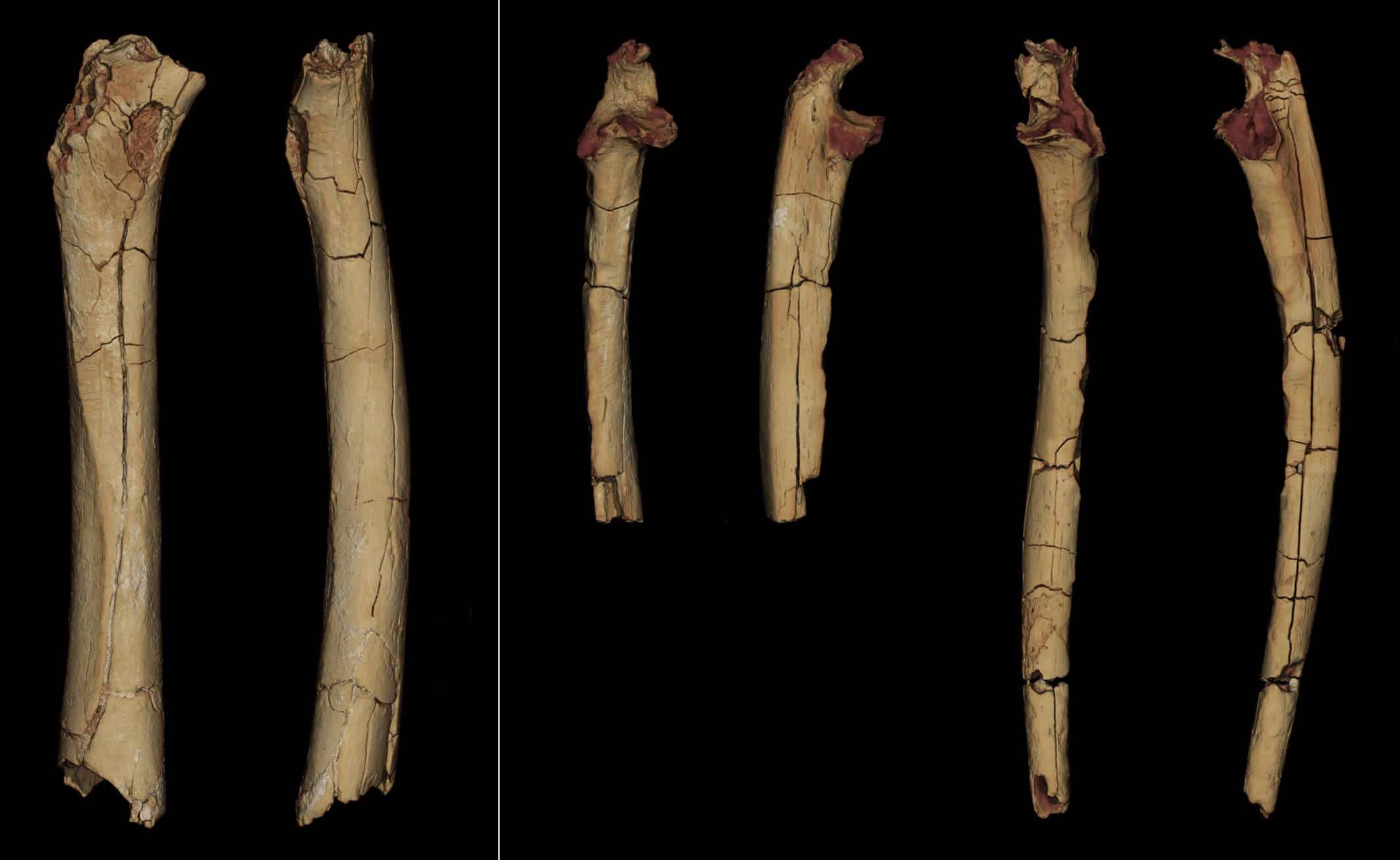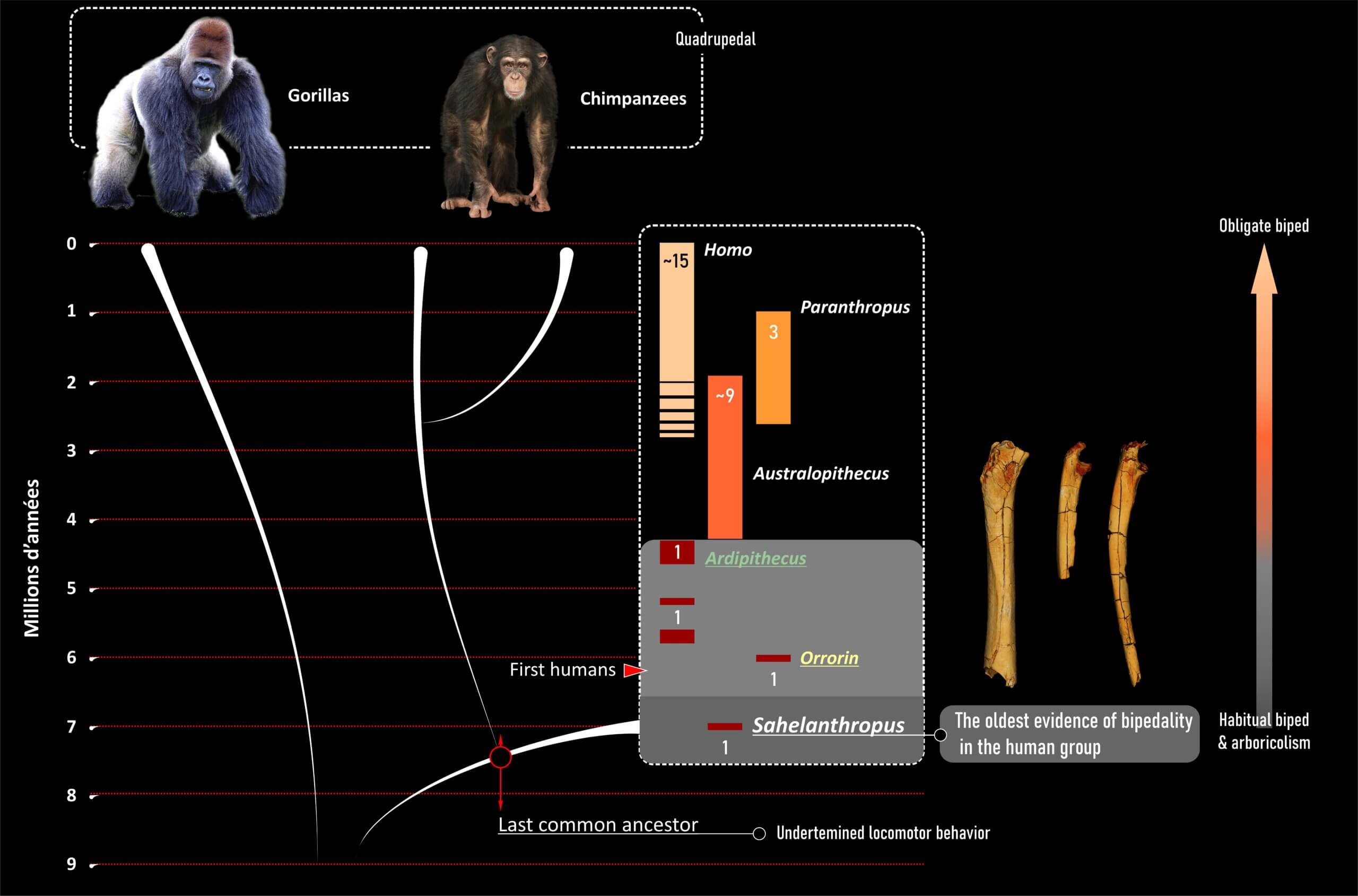Contrary to the prevailing assumption until now, a team of researchers from France and Chad discovered that walking on two feet does not characterize only Homo sapiens and may have evolved several times. several times and gradually
מחברים: Jean-Renault Bousserie, research director at CNRS, paleontologist, University of Poitiers, Endosa Lycius, the Franco-Chadian Paleoanthropological Mission, University of N'Djamena (Chad), Clarisse Nkwlanang Djatunaku, Research Professor in Paleontology, University of N'Djamena (Chad), Frank Guy, Paleoanthropology, University of Poitiers, Guillaume Daubert, Lecturer in Paleoanthropology, University of Poitiers, Lauren Palace, Paleontologist, Kyoto University, Makiya Hasan Taiso, Paleontologist, University of N'Djamena (Chad), Patrick Vigneault, Professor of Paleontology, University of Poitiers
Today's species research has provided a clear verdict on humanity's place in the living world: right next to chimpanzees and bonobos. However, this does not tell us much about Our earliest human representatives, their biology or geographic distribution - in short, how we became human. To do this, we must rely primarily on the morphology of frustratingly rare fossils, as information paleogenetic Preserved only from recent periods - and even then, in a fairly cool climate.
Since the 60s and identifying the very early era of Australopithecus Including The famous Lucy 3.18 million years old, discovered in 1974 in Ethiopia - Adopting walking on two feet Considered a crucial step in human evolution. Indeed, it is an essential trait that marks the transition from ancient human species to more modern species long before the significant increase in our brain size.
There was great anticipation for our research, published on August 24 in writing The journal Nature, on the skeleton of sahelanthropus tchadensis, who is a candidate for the title of the oldest known representative of humanity.
If so, were our distant ancestors human or non-human? In reality, asking the question in these terms borders on circular reasoning. Given that we have yet to discover the last common ancestor we share with chimpanzees, we do not know the initial state of human locomotion—bipedal or otherwise.
Until now, the earliest data available to us were the limb bones of Ororin (6 Ma, Kenya) and Ardipithecus (5.8 Ma–4.2 Ma, Ethiopia), which exhibited a different type of bipedalism than later species. It turns out that bipedalism is not an immutable characteristic of humanity and has its own history within our history. The right question is therefore: were the first representatives of humanity bilateral, and if so, to what extent and how? This is the question that the team Franco-Chadian Ours sought to answer it by investigating the much older remains (about 7 Ma) of Sahlanthropus.
The existence of Sahlanthropus first deduced In 2002 from a deformed but well-preserved skull (known as a tomai) and several other craniodental specimens discovered by The French-Chadian Paleoanthropological Mission (founded by Michel Brunt) in Toros-Manala in the Jurab Desert in Chad, from which at least three individuals originated. The study is based primarily on the morphology of the teeth, face and braincase of this species compared to more recent human fossils.
The limb bones described in our article include a partial left femur (femur) and two left and right ulna bones (along with the radius, the ulna is one of the two bones in the forearm that form our elbow). These bones were found in the same locality and in the same year in which the skull was found, but were identified later in 2004. It is likely that they belong to the same species as the skull, as only one large primate has been identified out of nearly 13,800 fossils representing about 100 different vertebrates in 400 localities in Toros-Manala. However, it is not known if the femur, ulna and skull belong to the same person, as at least three different individuals were found at the site.

A number of factors slowed our research, which began in 2004. For example, we were required to prioritize field study of other postcranial remains while struggling to analyze fragmented material. We eventually relaunched the project in 2017 and finished it five years later.
Bones studied from every possible angle
Given the poor preservation of these long bones (the femur, for example, has lost both ends), Short surgeries cannot provide reliable interpretations. That's why we studied them from all angles, both in terms of their external morphology and in terms of their internal structures.
To reduce uncertainty, we used an extensive array of methods, including direct observations and biometric measurements, XNUMXD image analysis, shape analysis (Morphometrics) and biomechanical indicators. We compared the Chadian material to today's fossil samples using a prism of 23 criteria. Individually, none of them can be used to offer a categorical interpretation of the material - indeed, there are no "magic" properties in paleoanthropology, and all will be subject to discussion in the scientific community.
At the same time, these features result in an interpretation of these fossils that is much stronger than any alternative hypothesis. This combination therefore indicates that Sahelanthropus moving on his two legs all the time. Both on the ground and on the trees. In the latter case, it is likely that it was accompanied by a quadrupedal gait accompanied by grasping branches, in contrast to the quadrupedal-lateral gait used by gorillas and chimpanzees, known as "walking on the knuckles", in which the weight is supported by the back of the phalanges.

The results are consistent with observations made on Ororin Vardipithecus, and they have several consequences. First, they reinforce the idea of a very early form of bipedalism in human history coexisting with other modes of locomotion. Therefore, there was no "sudden" appearance of a characteristic unique to humanity from the very beginning, but a long and slow transition lasting millions of years.
The human species is but a fragment of biological diversity
This phase of human evolution has thus occurred in fairly common ways throughout the history of life and throughout the world, and it reminds us that our species is but a sliver of biological diversity. This fact alone should lead us to rethink our attitude to the living world and to the parameters who control the hospitality of our planet.
Second, the characteristics of Sahlanthropus, Ororin and Ardipithecus point That the ancestor we share with chimpanzees was neither chimpanzee-like nor the exclusive chimpanzee we became. Contrary to the hypothesis that chimpanzees and bonobos Preserved their ancient morphology, it is more likely that their particular combination of vertical climbing and "toe walking" developed long after our split.
Finally, if sahelanthropus tchadensis It is a witness to human diversity among other things, it is, to this day, the only bipedal species known from that time. Given the complete, weakly diversified hominoid fossil record of Africa and Eurasia in the late Miocene (10 million years ago), the acquisition of bipedal walking by the human branch in the African continent remains the only well-documented hypothesis to date. At this point, bipedalism appears to be part of an opportunistic locomotion repertoire—flexible, able to exploit different environments—that fits well with the diverse paleoenvironment of Toros-Manala as reconstructed by our team's geologists, paleobotanists, and paleontologists.
This article was co-authored by Abdelmanah Moussa (University of N'Djamena, Chad).

4 תגובות
To the best of my knowledge, the dating is incomplete (the original Sahlanthropus chadensis was about 7 to 5 million years before our time, equivalent to Ororin, the Millennium Man from about 6 million years ago. The direction of the new research on different types of upright and or lateral walking is very interesting And so on. Could it be that in the vicinity of Lake Chad we are close to expanding the existing scientific knowledge?
It turns out that the more we discover, the less we understand each discovery that contradicts theories built over decades. And this is also true for the field of space exploration and physics.
The opening sentence "contrary to the prevailing assumption until now, a team of researchers from France and Chad discovered that walking on two feet is not only characteristic of Homo sapiens" is not accurate. As written later in the article, it has long been known that Homo erectus walked on two (hence its name) and Lucy, an Australopithecine like her, did it too. The innovation in the research is moving the date when our ancestors stood up, or at least combined walking on two legs, to a much earlier time, close to the point of separation between them and the chimpanzees.
interesting and important,
Until today it was accepted that the gay species existed for about three million years,
For the first to receive the name Homo was Homo Habilis (the skilled),
If I understood the researchers correctly, they are expanding the classification
up to the species that existed about seven million years ago
Which must change the approach to the classification and sorting of the gay type
And of the human species...